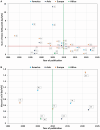Trans isomeric fatty acids in human milk and their role in infant health and development
- PMID: 38515522
- PMCID: PMC10954868
- DOI: 10.3389/fnut.2024.1379772
Trans isomeric fatty acids in human milk and their role in infant health and development
Abstract
It is well known that long chain polyunsaturated fatty acids (LCPUFAs) play an important role in neurodevelopment in the perinatal life. The most important source of these fatty acids is the diet, however, they can also be formed in the human body from their shorter chain precursors, the essential fatty acids. Since the WHO recommends exclusive breastfeeding for the first six months after birth, the exclusive source of these fatty acids for breastfed infants is human milk, which can be influenced by the mother's diet. Unsaturated fatty acids can have either cis or trans configuration double bond in their chain with distinct physiological effects. Cis isomeric unsaturated fatty acids have several beneficial effects, while trans isomers are mostly detrimental, because of their similar structure to saturated fatty acids. Trans fatty acids (TFAs) can be further subdivided into industrial (iTFA) and ruminant-derived trans fatty acids (rTFA). However, the physiological effects of these two TFA subgroups may differ. In adults, dietary intake of iTFA has been linked to atherosclerosis, insulin resistance, obesity, chronic inflammation, and increased development of certain cancers, among other diseases. However, iTFAs can have a negative impact on health not only in adulthood but in childhood too. Results from previous studies have shown that iTFAs have a significant negative effect on LCPUFA levels in the blood of newborns and infants. In addition, iTFAs can affect the growth and development of infants, and animal studies suggest that they might even have lasting negative effects later in life. Since the only source of TFAs in the human body is the diet, the TFA content of breast milk may determine the TFA supply of breastfed infants and thus affect the levels of LCPUFAs important for neurodevelopment and the health of infants. In this review, we aim to provide an overview of the TFA content in human milk available in the literature and their potential effects on infant health and development.
Keywords: development; human milk; infant; newborn; nutrition; review; trans fatty acid.
Copyright © 2024 Hatem, Kaçar, Kaçar, Szentpéteri, Marosvölgyi and Szabó.
Conflict of interest statement
The authors declare that the research was conducted in the absence of any commercial or financial relationships that could be construed as a potential conflict of interest.
Figures




Similar articles
-
trans Isomeric fatty acids are inversely related to the availability of long-chain PUFAs in the perinatal period.Am J Clin Nutr. 2013 Aug;98(2):543S-8S. doi: 10.3945/ajcn.112.039156. Epub 2013 Jul 3. Am J Clin Nutr. 2013. PMID: 23824720
-
Molecular effects of the consumption of margarine and butter varying in trans fat composition: a parallel human intervention study.Lipids Health Dis. 2022 Aug 18;21(1):74. doi: 10.1186/s12944-022-01675-1. Lipids Health Dis. 2022. PMID: 35982449 Free PMC article. Clinical Trial.
-
Plasma Trans Fatty Acid Levels, Cardiovascular Risk Factors and Lifestyle: Results from the Akershus Cardiac Examination 1950 Study.Nutrients. 2020 May 14;12(5):1419. doi: 10.3390/nu12051419. Nutrients. 2020. PMID: 32423040 Free PMC article.
-
Isomeric fatty acids: evaluating status and implications for maternal and child health.Lipids. 2001 Sep;36(9):997-1006. doi: 10.1007/s11745-001-0811-8. Lipids. 2001. PMID: 11724473 Review.
-
Dietary PUFA for preterm and term infants: review of clinical studies.Crit Rev Food Sci Nutr. 2005;45(3):205-29. doi: 10.1080/10408690590956378. Crit Rev Food Sci Nutr. 2005. PMID: 16048149 Review.
Cited by
-
Changes in the Fatty Acid Profile of Lactating Women Living in Poland-A Comparison with the Fatty Acid Profile of Selected Infant Formulas.Nutrients. 2024 Jul 25;16(15):2411. doi: 10.3390/nu16152411. Nutrients. 2024. PMID: 39125292 Free PMC article.
-
Assessment of the Presence of Partially Hydrogenated Oils (PHOs) as a Source of Industrially Produced Trans Fatty Acids (i-TFAs) in Packaged Foods in Poland, Pre- and Post-Implementation of EU Regulation 2019/649.Nutrients. 2025 Mar 18;17(6):1057. doi: 10.3390/nu17061057. Nutrients. 2025. PMID: 40292511 Free PMC article.
-
Factors Associated with Anthropometry Z-Scores in Exclusively Breastfed Infants Aged 0-6 Months in 10 Cities of China.Nutrients. 2025 Jun 29;17(13):2163. doi: 10.3390/nu17132163. Nutrients. 2025. PMID: 40647268 Free PMC article.
-
Investigating the Dietary Impact on Trans-Vaccenic Acid (Trans-C18:1 n-7) and Other Beneficial Fatty Acids in Breast Milk and Infant Formulas.Foods. 2024 Jul 9;13(14):2164. doi: 10.3390/foods13142164. Foods. 2024. PMID: 39063248 Free PMC article.
-
Determination of the Fatty Acid Profile and Lipid Quality Indices in Selected Infant Formulas.Molecules. 2024 Apr 29;29(9):2044. doi: 10.3390/molecules29092044. Molecules. 2024. PMID: 38731536 Free PMC article.
References
-
- Food and Drug Administration HHS . Food labeling: trans fatty acids in nutrition labeling, nutrient content claims, and health claims. Final rule. Fed Regist. (2003) 68:41433–506. https://www.govinfo.gov/content/pkg/FR-2003-07-11/pdf/03-17525.pdf - PubMed
Publication types
LinkOut - more resources
Full Text Sources

